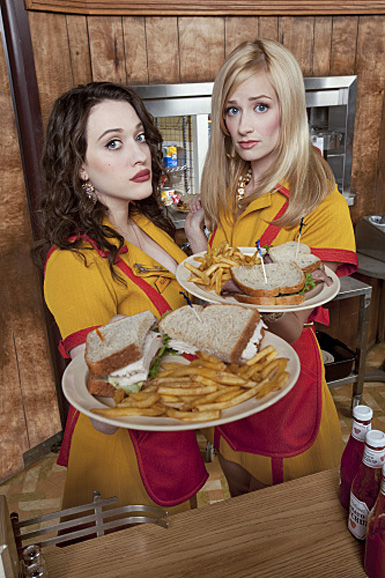2 Broke Girls (Or, One American Dream with a Side of Alienation)
Doyle Greene / Independent Scholar

The possessing class and the proletarian class represent one and the same human self-alienation. But the former feels satisfied and affirmed in this self-alienation, experiences the alienation as a sign of its own power, and possesses in it the appearance of a human existence. The latter, however, feels destroyed in this alienation, seeing its own impotence and the reality of an inhuman existence.
Karl Marx, “Alienation and Social Classes” (1844; emphasis original)
As the title indicates, the sitcom 2 Broke Girls (CBS, 2011) revolves around two young women and their economic plight.1 Max Black (Kat Dennings) is a sharp-tongued diner waitress living and working in Brooklyn.2 Despite her defiant demeanor, Max is grudgingly resigned to a life of insurmountable debt, piecemeal existence, service employment, and “no future.” Her counterpart is newly-hired waitress Caroline Channing (Beth Behrs), a billionaire socialite now penniless, homeless, and persona non gratis to her upper-class peers after her father was arrested for engineering a Ponzi scheme. The family fortune was seized by law enforcement and Caroline is woefully unprepared for the harsh reality of a low-income lifestyle.
However, while Max is the hardened product of the school of hard knocks, Caroline is a shrewd graduate of the Wharton School of Business; on her first day of work, Caroline made two dollars in tips through incompetent job performance but made over $300 selling Max’s cupcakes at a grossly inflated price. The two soon become friends, roommates, and business partners with the goal of earning $250,000 to open their own cupcake shop, and each episode ends with a title card showing the “current total” of the money accumulated (as of the first five episodes, $593.25).

Overall, 2 Broke Girls has initially proven to be a commercial and critical success for CBS, although The Washington Post and The Huffington Post negatively reviewed the premiere episode as derivative of The Odd Couple (ABC, 1970-1976), a somewhat inaccurate assessment. The Odd Couple centered on two heterosexual, middle-class men (slovenly sportswriter Oscar Madison and prissy photographer Felix Unger) separated from their wives and tensely living as roommates in a masculine-feminine gendered, same-sex domestic “couple” relationship. To be sure, Max and Caroline are confirmed heterosexuals, and 2 Broke Girls compensates with surplus sex-driven comedy to reinforce the fact they are two straight girls living together for reasons of economic necessity. Their duality is structured around Max’s raunchy “tough guy” swagger and seasoned “street” attitude – she even has a masculine first name and the surname “Black” – while Caroline exudes “spoiled diva” pomposity and strained “white-trying-to-pass-for-black” mannerisms.3 This binary of difference (masculinity/femininity, blackness/whiteness) is juxtaposed with Max representing the uncouth proletariat and Caroline the ostentatious bourgeoisie, together finding common ground as a class “odd couple” mutually separated from money.
In this way, the underlying drive of 2 Broke Girls is rectifying the conflicts and contradictions of class society by sustaining the affirmative ideology of the American Dream and the Horatio Alger myths (i.e. “from rags to riches” and “pulling yourself up by the bootstraps”). Louis Althusser suggests
Ideology…is the expression of the relation between [people] and their “world,” that is the (overdetermined) unity of the real relation and the imaginary relation between them and their conditions of existence. In ideology the real relation is inevitably invested in the imaginary relation, a relation that expresses a will (conservative, conformist, reformist, or revolutionary), a hope or nostalgia, rather than describing a reality.4
For both Max and Caroline, the real relation is being members of the working poor while the imaginary relation is their mutual hope of social mobility. Framing this around Marx’s critique of alienation and social class, Caroline represents the possessing class suddenly demoted to the proletariat class. Her financially empowered “appearance of a human existence” is abruptly transformed into an impoverished and powerless “reality of an inhuman existence,” and her bourgeois alienation is now realized as proletariat alienation. Max is the proletariat class trapped in an economically impotent “reality of an inhuman existence” with no apparent recourse until Caroline provides a glimpse of a better future; more correctly, a false consciousness generated around the allure of affluence as the “appearance of a human existence” where proletariat alienation is now imagined around bourgeois alienation. In the episode “And the Rich People Problems” (2011), the duo sneaks into Caroline’s impounded townhouse to retrieve a dental bite guard. When Max sees how Caroline lived before her drastic class adjustment, she is unable to conceal her awe to the point that Caroline tells Max she is “embarrassing her.” Max emphatically responds: “This is nothing to be embarrassed about!” Not only does Max develop greater sympathy for Caroline’s situation as well as new respect for Caroline’s resolve to overcome it, but Max briefly experiences the possibility of economic luxury – and begins to desire it as well.

Ultimately, the overarching situation of 2 Broke Girls can be read as two alienated classes united by one ideology—the American Dream—in the aftershocks of the 2008 economic collapse and ongoing recession. Caroline had it all and lost it all. She needs Max to earn it back “the right way” by working her way up from the bottom, not sponging off the capital generated by financial fraud (i.e. Wall Street improprieties, the Bernie Madoff scandal). Max never had it and never thought she could have it, but sees the opportunity to indeed have it all. She needs Caroline to earn it all through goal-driven entrepreneurial enterprise, not through a floundering survival from paycheck to paycheck.5 Rather than disillusionment with the American Dream and expressing a mass resentment of the system (i.e. the recent proliferation of “Occupy” demonstrations), Max embraces the traditional ideological “imaginary” of upward mobility through individual effort and self-determination.

Indeed, the class struggle in 2 Broke Girls is not between the rich and the poor, but is the poor extricating themselves from their lot in life. What Max and Caroline both seek is a way out of the “inhuman existence” of the proletariat and poverty in favor of “the appearance of a human existence” of the bourgeoisie and wealth – or, at the least, middle-class self-sufficiency as small business owners. Sustaining the two broke girls is ideology as their imaginary relation to their real conditions of social existence.
Image Credits:
www.poptower.com/2-broke-girls-pictures.htm
Please feel free to comment.
NOTES
- Co-created by Sex and the City writer-director Michael Patrick Hill and comedienne Whitney Cummings, CBS bought 2 Broke Girls “on speculation” with a guaranteed production deal and awarded the sitcom the prized Monday night time slot between the long-running How I Met Your Mother and Two and a Half Men. By the third episode, impressive ratings prompted CBS to order a full season. [↩]
- More specifically, Max and Caroline live in the Williamsburg neighborhood of Brooklyn, with numerous jokes directed at the more affluent “hipster” residents of the community and their subculture. [↩]
- 2 Broke Girls primarily functions around “stereotypes,” and this becomes especially pronounced in the main supporting cast. The diner cashier Earl (Garrett Morris) is an older, eminently streetwise black male. Diner owner Han Lee (Mathew Moy) is a young, extremely uncool Asian male. The diner cook Oleg (Jonathan Kite) is an exceedingly seedy and sexist Russian male (see illustration four, lower right). In this respect, 2 Broke Girls constructs a form of Otherness around Americans (Max, Caroline, Earl) versus immigrants (Han and Oleg).[↩]
- Louis Althusser, For Marx, trans. Ben Brewster (New York: Verso, 1991), 233-4.[↩]
- Put another way, Caroline has the bourgeois brain, vision, and occasionally overbearing confidence Max lacks to astutely plan the dream (management) whereas Max has the proletariat backbone, skill, and consistently cynical attitude Caroline lacks as they arduously pursue the dream (labor). [↩]
Interesting article and I wish I had more time to discuss rather than just say the following but:
Though I kind of hate myself for policing terminology, I also can’t restrain myself from saying that the term comedienne is pretty dated. Female comics generally dislike and take offense to being referred to that way. Female comic or comedian or just comic or comedian is preferred.
Great article Doyle. If we understand television to largely be a medium that represents the middle class, I wonder why/how these white lower class women make it to television. Are we as viewers reassured by the idea that they aren’t really poor or does the economic climate (as you mentioned) make it OK to represent these people in the economically depressed situation? I also find it interesting that this show is on CBS – a network that has in recent history skewed demographically older. Is CBS attempting to make their demo younger?
Hi Erin and Al,
Erin, thanks for pointing out the terminology gaff. In short, I stand corrected, and my apologies.
Al, thanks for the comments and they raise some pertinent issues I’ll try to address, as admittedly underdeveloped as my thoughts are at this stage (please feel free to augment). I didn’t think of the demographic question. Since Everybody Loves Raymond ended ca. 2005, the CBS Monday night flagship sitcom has been Two and a Half Men and, along with that, How I Met Your Mother . Both shows feature a predominatly well-off — or at least reasonably economically secure — younger, professional, upwardly mobile cast of characters, which would seem to correspond to an network “imagined audience” of these shows. My take would be that the introduction of young, lower-class characters to the CBS Monday night line-up with 2 Broke Girls is very much a response to the post-2008 economic context and that the prospect (or fear) of downward mobility seems more “real” that upward mobility for a lot of people. For me, it’ll be interesting how 2 Broke Girls develops the “rags to riches” struggle and if it becomes a kind of critique of the American Dream as something that is never attained or even attainable (The Honeymooners)or if they indeed succeed (the evolution of Archie Bunker from blue-collar bigot to more moderate small-business owner over the course of All in the Family and Archie Bunker’s Place).
Nice article. The program seems to be rife with neoliberal languages and imaginaries. The imagined escape from the poor wages of the service industry is through entrepreneurialism, rather than through fighting for a living wage, solidarity with kitchen employees, etc. — individualized responses to structural problems, as usual. Depictions of working class characters on television often seem to be predicated on aspiration through entrepreneurialism — sometimes in the form of the harebrained scheme. It is interesting to consider this program alongside a show like Roseanne. Thinking about the life of a family such as the Conners under current economic conditions in the Midwest conjures up unfunny pictures of chronic under- or unemployment and home foreclosure. Making poverty both sexy and child-like (2 Broke “Girls”) implies future growth and escape. It is clearly more palatable to see broke single people, we can laugh because their plight seems temporary. It certainly will be interesting to see how the economic narrative will unfold in relationship to the potential romantic couplings down the road.
we can laugh because their plight seems temporary. It certainly will be interesting to see how the economic narrative will unfold in relationship to the potential romantic couplings down the road.
Interesting stuff. I wish TV would explore working class lives more often. Perhaps political correctness is partly to blame here. I enjoyed Greg Garcia’s “My Name Is Earl” and his current show, “Raising Hope,” although both shows have been criticized for apparently creating condescending portraits of working class folk. I think such criticisms are an over-reaction. I also liked “Roseanne,” which was, in many ways, an antidote to “The Cosby Show” and it’s image of perfect family life. (The Huxtables were wealthy, but even they could never have afforded a NY apartment that big. But then, on TV, New Yorkers, with the exception of the Kramdens have always had giant apartments.) Perhaps, in the final analysis, what people want from TV is escapism. People come home from a hard day’s work and want to be entertained with a pleasant image of a life where things are nice and money problems don’t exist. And that’s why TV has generally had more shows of middle class/affluent types than the working class. I don’t see that changing anytime soon.
Hi,
Really great analysis. I just wanted to let you know that I am including you as a source in my thesis and as part of a PCA Conference panel I’m doing next week on “The New Normal, Social Class and American Sitcoms”
Pingback: Volume Blog
Straightforward comedy aimed at the (18 to 25 age group)? We don’t have to be from New York to get the references. No taboos here. Nothing is off limits. Funny and upbeat.